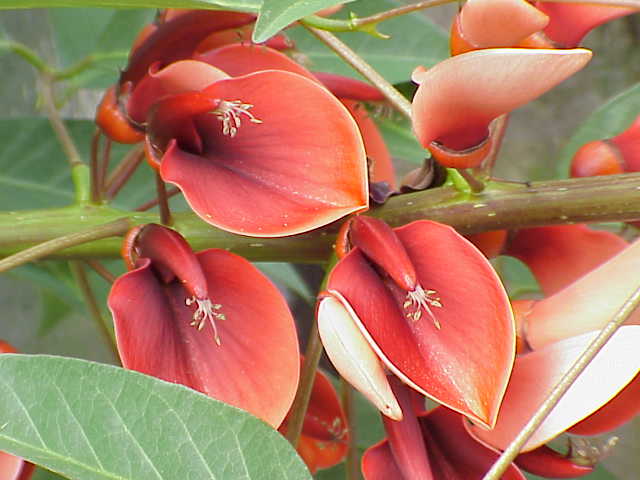|
Cranberry Gourd
''Abobra'' is a monotypic genus of the gourd family containing the one species ''Abobra tenuifolia'' ( syn. ''Abobra viridiflora'' Naudin, ''Bryonia tenuifolia'' Hook. & Arn.). It is a diecious, perennial climbing plant reaching up to the height of . It is native to South America (Argentina, Brasil, and Uruguay) and is sometimes cultivated as ornamental plant Ornamental plants or ''garden plants'' are plants that are primarily grown for their beauty but also for qualities such as scent or how they shape physical space. Many flowering plants and garden varieties tend to be specially bred cultivars th ...s and also for its edible fruits. The flowers exude a strong fragrance and are of pale green color and blossom between July and August. The seeds ripen between September and October. The fruit is ovoid and has a diameter of 14 mm. Common names include cranberry gourd. References * External linksPlants For A Future: ''Abobra tenuifolia'' Flora of Argentina Flora of Br ... [...More Info...] [...Related Items...] OR: [Wikipedia] [Google] [Baidu] |
Charles Victor Naudin
Charles Victor Naudin (14 August 1815 in Autun – 19 March 1899 in Antibes) was a French naturalist and botanist. Biography Naudin studied at Bailleul-sur-Thérain in 1825, at Limoux, and at the University of Montpellier from which he graduated in 1837. The following year he was working as a private tutor; he obtained his doctorate in 1842. He taught until 1846, when he joined the herbarium of the National Museum of Natural History. He collaborated with Augustin Saint-Hilaire on the publication of the Brazilian flora and introduced the first seeds of ''Jubaea chilensis'' in France. In 1853, botanists Planch. & Jean Jules Linden, Linden published ''Naudinia'' is a monotypic genus of flowering plants from Colombia belonging to the family Rutaceae, and named in Naudin's honour. He taught at Chaptal College as professor of zoology, but a neurological disease left him deaf. He became an assistant naturalist in 1854 and married in 1860. He entered the Academy of Sciences in 1863 w ... [...More Info...] [...Related Items...] OR: [Wikipedia] [Google] [Baidu] |
John Gillies (botanist)
John Gillies (c. 1792–1834) was a Scottish naval surgeon who later became an explorer and botanist, travelling extensively in South America. Educated at the University of Edinburgh, he served in the Royal Navy during the Napoleonic Wars. Afflicted by tuberculosis, Gillies left the UK aged 28 for South America in the hope that the climate would improve his fragile health. He spent eight years there, mostly in Argentina, surviving wars, civil unrest, and chronic ill health, sending numerous plants to William Jackson Hooker, Hooker at the Royal Botanic Gardens Kew before returning in 1828. He died aged 42 at Edinburgh on 24 November 1834, his remains interred at Old Calton Cemetery, Calton.Gibbs, F. W. (1951). John Gillies, M.D., Traveller and Botanist, 1792–1834. ''Notes and Records of the Royal Society of London'' 1951. The Royal Society, London Eponymy A number of plants were named for Gillies: * (Amaryllidaceae) ''Gilliesia'' Lindl. * (Acanthaceae) ''Adhatoda gilliesii'' Ne ... [...More Info...] [...Related Items...] OR: [Wikipedia] [Google] [Baidu] |
Cucurbitaceae
The Cucurbitaceae (), also called cucurbits or the gourd family, are a plant family (biology), family consisting of about 965 species in 101 genera.Cucurbitaceae Juss. ''Plants of the World Online''. Retrieved 10 June 2024. Those of most agricultural, commercial or nutritional value to humans include: *''Cucurbita'' – Squash (plant), squash, pumpkin, zucchini (courgette), some gourds. *''Lagenaria'' – calabash (bottle gourd) and other, ornamental gourds. *''Citrullus'' – watermelon (''C. lanatus'', ''C. colocynthis''), plus several other species. *''Cucumis'' – cucumber (''C. sativus''); various melons and vines. *''Momordica'' – Momordica charantia, bitter melon. *''Luffa'' – commonly called 'luffa' or ‘luffa squash'; sometimes spelled loofah. Young fruits may be cooked; when fully ripened, the ... [...More Info...] [...Related Items...] OR: [Wikipedia] [Google] [Baidu] |
William Jackson Hooker
Sir William Jackson Hooker (6 July 178512 August 1865) was an English botany, botanist and botanical illustrator, who became the first director of Kew Gardens, Kew when in 1841 it was recommended to be placed under state ownership as a botanic garden. At Kew he founded the Kew Herbarium, Herbarium and enlarged the gardens and arboretum. Hooker was born and educated in Norwich. An inheritance gave him the means to travel and to devote himself to the study of natural history, particularly botany. He published his account of an expedition to Iceland in 1809, even though his notes and specimens were destroyed during his voyage home. He married Maria, the eldest daughter of the Norfolk banker Dawson Turner, in 1815, afterwards living in Halesworth for 11 years, where he established a herbarium that became renowned by botanists at the time. He held the post of Regius Professor of Botany at Glasgow University, where he worked with the botanist and lithographer Thomas Hopkirk and e ... [...More Info...] [...Related Items...] OR: [Wikipedia] [Google] [Baidu] |
George Arnott Walker-Arnott
George Arnott Walker Arnott of Arlary (6 February 1799 – 17 April 1868) was a Scottish botanist. He collaborated with botanists from around the world and served as a Regius Professor of Botany (Glasgow), regius professor of botany at the University of Glasgow. An orchid genus ''Arnottia'' was named in his honour in 1828. Early life George Arnott Walker Arnott was born in Edinburgh, on 6 February 1799, the son of David Walker Arnott of Arlary (near Kinross). He grew up in Edenshead and Arlary, and attended Milnathort Parish School then the High School of Edinburgh from 1807. He received an Master of Arts, AM degree in 1818. He took to mathematics and was recognized by John Leslie (physicist), Sir John Leslie and John Playfair. He wrote articles in Tilloch's Philosophical Magazine on ''Observations on the Solution of Exponential Equations'' (1817) and ''Comparison between the Chords of Arcs employed by Ptolemy and those now in use'' (1818). He then joined to study law in Edi ... [...More Info...] [...Related Items...] OR: [Wikipedia] [Google] [Baidu] |
South America
South America is a continent entirely in the Western Hemisphere and mostly in the Southern Hemisphere, with a considerably smaller portion in the Northern Hemisphere. It can also be described as the southern Subregion#Americas, subregion of the Americas. South America is bordered on the west by the Pacific Ocean, on the north and east by the Atlantic Ocean, and to the south by the Drake Passage; North America and the Caribbean Sea lie to the northwest. The continent includes twelve sovereign states: Argentina, Bolivia, Brazil, Chile, Colombia, Ecuador, Guyana, Paraguay, Peru, Suriname, Uruguay, and Venezuela; two dependent territory, dependent territories: the Falkland Islands and South Georgia and the South Sandwich Islands; and one administrative division, internal territory: French Guiana. The Dutch Caribbean ABC islands (Leeward Antilles), ABC islands (Aruba, Bonaire, and Curaçao) and Trinidad and Tobago are geologically located on the South-American continental shel ... [...More Info...] [...Related Items...] OR: [Wikipedia] [Google] [Baidu] |
Ornamental Plant
Ornamental plants or ''garden plants'' are plants that are primarily grown for their beauty but also for qualities such as scent or how they shape physical space. Many flowering plants and garden varieties tend to be specially bred cultivars that improve on the original species in qualities such as color, shape, scent, and long-lasting blooms. There are many examples of fine ornamental plants that can provide height, privacy, and beauty for any garden. These ornamental perennial plants have seeds that allow them to reproduce. One of the beauties of ornamental grasses is that they are very versatile and low maintenance. Almost all types of plant have ornamental varieties: trees, shrubs, climbers, grasses, succulents, aquatic plants, herbaceous perennials and annual plants. Non-botanical classifications include houseplants, bedding plants, hedges, plants for cut flowers and ''foliage plants''. The cultivation of ornamental plants comes under floriculture and tree nurseries ... [...More Info...] [...Related Items...] OR: [Wikipedia] [Google] [Baidu] |
Project Gutenberg
Project Gutenberg (PG) is a volunteer effort to digitize and archive cultural works, as well as to "encourage the creation and distribution of eBooks." It was founded in 1971 by American writer Michael S. Hart and is the oldest digital library. Most of the items in its collection are the full texts of books or individual stories in the public domain. All files can be accessed for free under an open format layout, available on almost any computer. , Project Gutenberg had reached over 75,999 items in its collection of free eBooks. The releases are available in plain text as well as other formats, such as HTML, PDF, EPUB, MOBI, and Plucker wherever possible. Most releases are in the English language, but many non-English works are also available. There are multiple affiliated projects that provide additional content, including region- and language-specific works. Project Gutenberg is closely affiliated with Distributed Proofreaders, an Internet-based community for proofr ... [...More Info...] [...Related Items...] OR: [Wikipedia] [Google] [Baidu] |
Flora Of Argentina
The environment of Argentina is highly biodiverse. Biodiversity Flora Subtropical plants dominate the Gran Chaco in the north, with the '' Dalbergia'' genus of trees well represented by Brazilian rosewood and the quebracho tree; also predominant are the wacho white and black algarrobo trees ('' Prosopis alba'' and ''Prosopis nigra''). Savannah-like areas exist in the drier regions nearer the Andes. Aquatic plants thrive in the wetlands of Argentina. In central Argentina the ''humid pampas'' are a true tallgrass prairie ecosystem. In Argentina forest cover is around 10% of the total land area, equivalent to 28,573,000 hectares (ha) of forest in 2020, down from 35,204,000 ha in 1990. In 2020, naturally regenerating forest covered 27,137,000 ha and planted forest covered 1,436,000 ha. Of the naturally regenerating forest 0% was reported to be primary forest (consisting of native tree species with no clearly visible indications of human activity) and around 7% o ... [...More Info...] [...Related Items...] OR: [Wikipedia] [Google] [Baidu] |
Flora Of Brazil
The wildlife of Brazil comprises all naturally occurring animals, plants, and fungus, fungi in the South American country. Home to 60% of the Amazon Rainforest, which accounts for approximately one-tenth of all species in the world, Brazil is considered to have the greatest biodiversity of any country on the planet. It has the most known species of plants (60,000), freshwater fish (3,000), Amphibian, amphibians (1,188), Snake, snakes (430), Insect, insects (90,000) and mammals (775). It also ranks third on the list of countries with the most bird species (1,971) and the third with the most reptile species (848). The number of fungal species is unknown (+3,300 species).Da Silva, M. and D.W. Minter. 1995. ''Fungi from Brazil recorded by Batista and Co-workers''. Mycological Papers 169. CABI, Wallingford, UK. 585 pp. Approximately two-thirds of all species worldwide are found in tropical areas, often coinciding with developing cou ... [...More Info...] [...Related Items...] OR: [Wikipedia] [Google] [Baidu] |
Flora Of Uruguay
The flora of Uruguay consists of 2,500 species distributed among 150 native and foreign biological families. Approximately 80% of Uruguay is prairie, with grasses predominating. Uruguay is primarily a grass-growing land, with vegetation that is essentially a continuation of the Argentine Pampas. Forest areas are relatively small. Trees grow in bunches. Forested areas are much smaller than in the pampas, but contain a mix of hardwoods and softwoods, while eucalyptus were imported from Australia. "Ceibo", or '' Erythrina cristagalli'', is the national flower. Herbs Uruguay contains many herbs, ferns, and flowers. Riverine forests Natural forests in Uruguay mainly grow near rivers in the countryside. The native forests are composed of more than 500 native species, including palms. The most abundant are "sauce criollo" ('' Salix humboldtiana''), "sarandí colorado" (''Cephalanthus glabratus''), "sarandí blanco" ('' Phyllanthus sellowianus'') and "mataojos" ('' Pouteria salicif ... [...More Info...] [...Related Items...] OR: [Wikipedia] [Google] [Baidu] |







